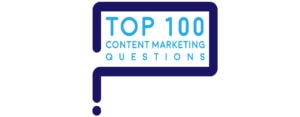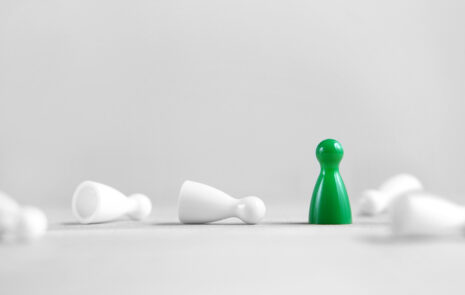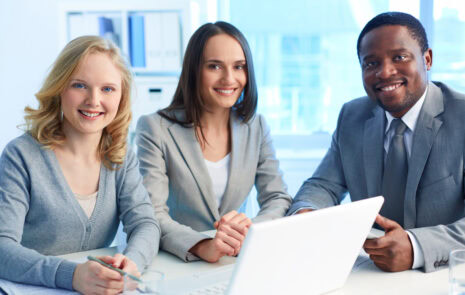
“How can an advertising and content team collaborate for maximum results?”
How can advertising and content collaborate? A marketer from Farmers Insurance asked this question. It’s one of the Top 100 Questions on Content Marketing.
Create a community of communicators who collaborate

Most companies do many forms of internal and external communications. To maximize the results from advertising and content, you need to convene this whole community regularly.
Each discipline needs to play its clear role, while aligning for maximum company results:
- Advertising drives paid media.
- Content marketing drives owned media.
- PR (public relations) drives earned media.
- Either PR or HR (human resources) drives employee communications.
- In public companies, investor relations (IR) drives investor communications.
Let’s start with the advertising and content teams. Too often, communicators in separate organizations work at cross-purposes because they can’t see each other’s work.
Maximum efficiency
To get advertising and content marketing working together at maximum efficiency takes a companywide effort to break down siloes.
It’s real work to align all the communicators. It’s harder in larger companies because of organizational silos. Yet it’s so rewarding to see the results of advertising and content teams working closely together.
Build a big tent. Invite key decision-makers and communicators in. Together, you can co-create one marketing and communications mission, one marketing and communications strategy, and one unified company message that’s meaningful to all stakeholders.
That’s how advertising and content teams maximize results.
One company, one message, one voice
One way forward is to engage your CEO, CFO and C-suite in a workshop to create a unified company message. The right message tells all company stakeholders what’s in it for them, what’s your company’s purpose, and why they should believe that.
During the coronavirus crisis, it’s especially important to address the company’s wider audiences. What exactly is your company doing for customers, employees and communities?
The best marketers are addressing these wider audiences in their advertising and content today.

Unfortunately, purely sales-oriented messages seem tone-deaf right now. Those messages need to be set aside for a while.
This big-tent approach is harder to organize in bigger companies. It may take you some time to organize a C-Suite meeting on messaging, even if you’re a vice president.
When I worked as a PR manager in a Fortune 50 company, it took me an entire year of asking to land an interview with the CEO so I could write his letter for the annual report to shareholders.
Why did it take so long? Because I had to secure buy-in from my director, VP, and CCO, plus the CEO.
Being persistent paid off.
The CEO interview not only helped the annual report, it clarified the company message.
Here’s a step-by-step method to co-create one unified message for all your stakeholders on a Message Map. Once you engage the execs, involve communication leaders from across the organization: marketing, public relations, investor relations, employee communications, and community relations.
Bring internal clients to the table too – such as sales, customer service, and product. The more voice you give internal clients and communications colleagues, the more likely they are to buy in to your big tent ideas.
Here’s how to build a big tent to align your company around one mission, strategy, and message.
Create an internal council with representatives from each communications discipline to coordinate activity in the quarter ahead. The council’s job is to:
- Coordinate monthly, quarterly and annual plans.
- Review all-in analytics results monthly or quarterly.
- Learn each other’s strengths.
- Develop mutual trust over time.
When you weave the strengths of all the communications disciplines together, companies speak with one authoritative voice. So, advertising and content maximize effectiveness, rather than inadvertently working at cross-purposes.
The strengths of advertising and content marketing complement each other
Let’s dive deeper into the respective strengths of advertising and content marketing.
Advertising is all about the brand, with a sales message delivered through paid media campaigns. Ads interrupt the audience when they’re doing something else.
Because ads are the brand talking about the brand, they come across as self-serving.
In contrast, content marketing is all about the needs of the audience, addressing topics they care about and answering their questions.
Content marketing is designed as a long-term play that takes a multiyear commitment. For example, the Michelin Guide has published for over 120 years. Not a short-term campaign.
Play to the strengths of each. In summary:

Content marketing appears in any type of media – paid, earned or owned. Since it serves the audience or “tribe” that includes your stakeholders, they seek it out.
Direct paid and earned media audiences to the content you own

The key to working together across disciplines: all paid and all earned media should point people to the content your own — on your website, email, blog and printed materials.
Why point everything to owned media? Because the whole idea of content marketing is to build up your list of people who subscribe to your owned content.
Over time, content marketing builds up a relationship of trust with audiences. It generates awareness and interest to help people form an intention to buy, then act on it. Content generates leads, qualifies customers and even closes sales.
What are your marketing peers doing with content in paid media?
Let’s look at how marketers blend content and paid media such as advertising.
Consumer marketers
About 6 out of 7 consumer marketers use paid channels for content marketing today, says the 2020 Content Marketing Institute/Marketing Profs B2B (business to business) survey. Consumer marketers’ focus is on paid social media, search engine advertising and banner ads.
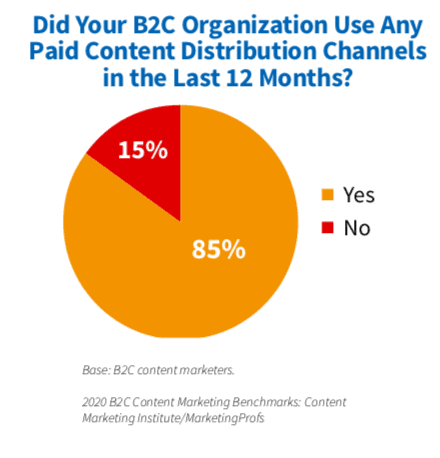

Facebook is the #1 social media platform for consumer marketers, both organic and paid. Instagram ranks second.
Business marketers
Business marketers are less likely than consumer marketers to use paid media for content marketing. Overall, about 2 out of 3 business marketers use paid channels for content.
B2B marketers use paid channels such as social media, sponsorships, and search engine marketing the most. They prefer LinkedIn for organic and paid social media.

Size matters
Large companies and companies with bigger marketing budgets are much more likely to use paid media for content marketing than smaller companies or companies with smaller marketing budgets.
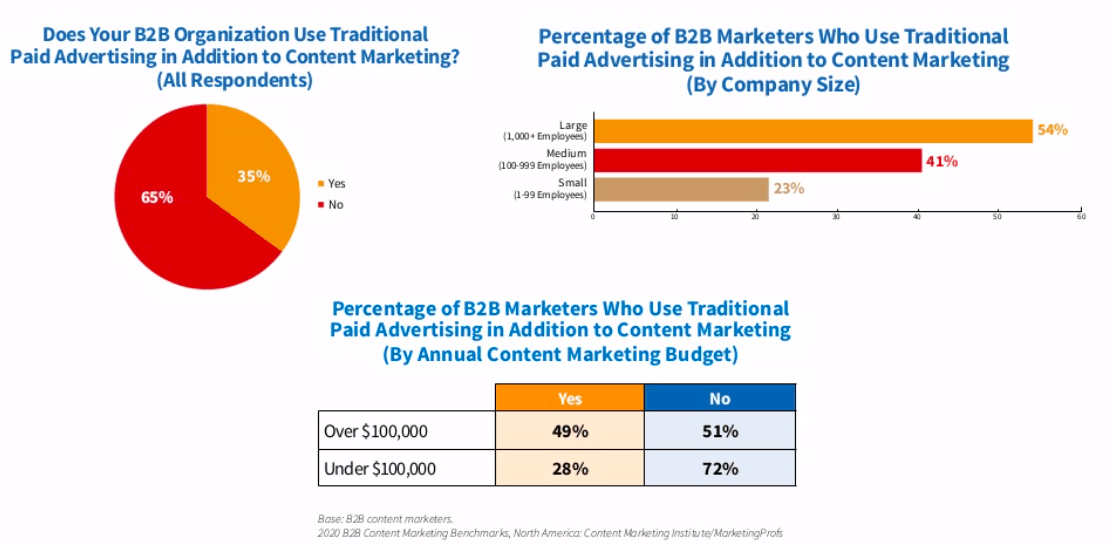
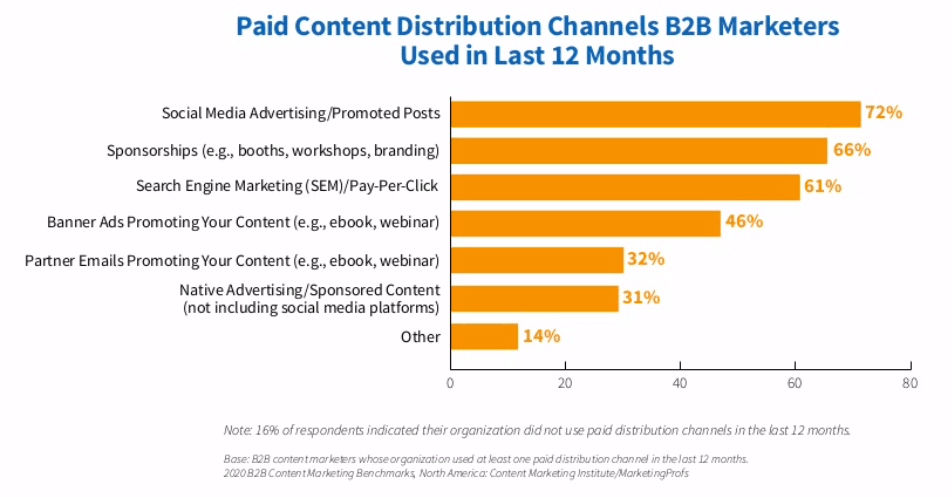
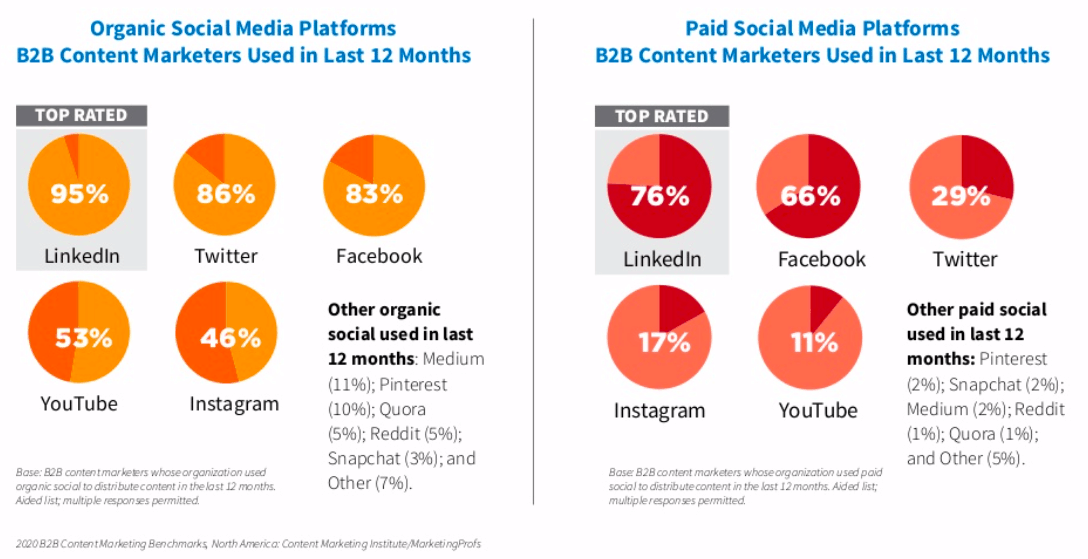
One more content marketing insight that’s particular to B2B marketing: about 1 out of 3 business marketers is shifting budgets from paid advertising to content marketing.
That behavior may be a harbinger of things to come for consumer marketers.

“How can an advertising and content team collaborate for maximum results?” is one of marketers’ Top 100 Questions on Content Marketing. Here are the answers.
